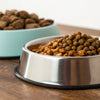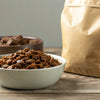Should You Feed Dogs Wet and Dry Food? A Comprehensive Guide
- Houndsy
Table of Contents
- Introduction
- Understanding Dog Food Types
- The Benefits of Mixing Wet and Dry Dog Food
- Considerations When Feeding Wet and Dry Food
- How to Mix Wet and Dry Dog Food Effectively
- Conclusion
Introduction
Did you know that approximately 60% of dog owners in the United States are unsure about the best type of food to feed their furry companions? With the plethora of options available—ranging from dry kibble to wet canned food—it's no wonder many owners feel overwhelmed. As devoted pet parents, we want nothing but the best for our dogs, and understanding their dietary needs is essential for their overall health and happiness.
In today's blog post, we will explore the question: Should you feed dogs wet and dry food? We will delve into the differences between wet and dry dog food, the benefits of each, and how to determine the best feeding strategy for your beloved pet. By the end of this article, you will have a clearer understanding of how to create a balanced diet that meets your dog's nutritional needs while also catering to their preferences.
At Houndsy, we believe in enhancing the everyday experience of pet owners, and that includes making informed choices about your dog’s diet. So, let’s embark on this journey together to discover the ins and outs of dog food nutrition!
Understanding Dog Food Types
What is Dry Dog Food?
Dry dog food, commonly referred to as kibble, is the most popular choice among dog owners due to its convenience and long shelf life. It consists of dehydrated ingredients that are extruded and cooked to form bite-sized pieces. Dry food typically contains around 10% moisture, which makes it easy to store and portion out for your pet.
Some advantages of dry dog food include:
- Convenience: Kibble is easy to measure and can be left out for extended periods without spoiling. This is particularly beneficial for dogs that prefer to graze throughout the day.
- Dental Health: The crunchy texture of kibble can help reduce tartar buildup and promote dental health as dogs chew their food.
- Cost-Effectiveness: Dry food is generally less expensive than wet food, making it a budget-friendly option for many pet owners.
What is Wet Dog Food?
Wet dog food, often found in cans or pouches, has a significantly higher moisture content—typically between 70% to 80%. This food is usually made from meat and meat by-products, combined with water and other ingredients to create a palatable meal. The texture can range from pâté to chunks in gravy, providing variety for your dog.
Benefits of wet dog food include:
- Higher Moisture Content: Wet food can be an excellent option for dogs that don't drink enough water, as it helps keep them hydrated.
- Flavor Appeal: The aroma and texture of wet food can entice picky eaters or dogs with decreased appetites, making it easier for them to consume their meals.
- Easier to Chew: For senior dogs or those with dental issues, wet food can be much easier to manage compared to dry kibble.
The Benefits of Mixing Wet and Dry Dog Food
While both dry and wet dog food have distinct advantages, combining the two can provide the best of both worlds. Here are several compelling reasons to consider mixing wet and dry dog food:
1. Enhanced Flavor and Variety
Just like us, dogs can become bored with the same meal every day. By mixing wet and dry food, we can enhance the flavor and texture of their meals, making mealtime more exciting. This variety can encourage them to eat more consistently and enjoy their meals.
2. Improved Hydration
For dogs that struggle to drink enough water, incorporating wet food into their diet can boost their overall fluid intake. This is especially crucial for dogs with urinary or kidney issues, where hydration plays a vital role in their health.
3. Dental Health Benefits
While wet food is often easier to eat, the combination of both wet and dry food allows for the dental benefits of kibble. The crunchiness of dry food can help scrape off plaque and tartar, promoting better oral health.
4. Tailored Nutrition
Mixing wet and dry food enables us to customize our dog's diet to meet their specific needs. For instance, if we have a senior dog that requires extra hydration but also needs the dental benefits of kibble, creating a balanced mix can address both concerns.
Considerations When Feeding Wet and Dry Food
While the benefits of mixing wet and dry dog food are numerous, there are some important considerations to keep in mind:
1. Nutritional Balance
It’s essential to ensure that the mixture of wet and dry food still meets your dog’s nutritional needs. We should consult with our veterinarian to calculate the appropriate proportions of each type of food based on our dog's age, weight, activity level, and any specific health concerns.
2. Storage and Freshness
Wet food has a shorter shelf life once opened and must be refrigerated to prevent spoilage. When mixing wet and dry food, we need to be mindful of how long the mixture sits out to avoid waste and ensure our dog is eating fresh food.
3. Monitoring Caloric Intake
Mixing two types of food can complicate calorie counting. We must be diligent about tracking the total daily caloric intake, including treats, to prevent overfeeding and potential weight gain.
4. Gradual Transition
If we decide to introduce a new diet or mix, it’s best to do so gradually. A sudden change in diet can upset a dog’s stomach, leading to digestive issues. We should mix a small amount of new food with their current food and gradually increase the proportion over several days.
How to Mix Wet and Dry Dog Food Effectively
To create a successful mixed feeding routine, we can follow these steps:
Step 1: Consult With Your Veterinarian
Before making any dietary changes, we should consult our veterinarian to discuss our dog’s specific needs and obtain tailored recommendations.
Step 2: Choose High-Quality Food
At Houndsy, we are committed to quality and functionality, and we encourage you to choose high-quality wet and dry foods that align with your dog's health requirements. Look for products that use real meat as the first ingredient and are free from artificial additives.
Step 3: Measure Portions Carefully
Using a measuring cup, we can portion out the appropriate amounts of wet and dry food according to our veterinarian's recommendations. This ensures that our dog receives the right nutrients without overfeeding.
Step 4: Monitor Your Dog's Response
After introducing the mixed feeding routine, we should observe our dog’s appetite, energy levels, and overall health. If we notice any adverse reactions or changes, we may need to adjust the ratios or consult our vet for further guidance.
Step 5: Maintain Consistent Feeding Times
Establishing a regular feeding schedule helps our dog understand when to expect meals, which can reduce anxiety around mealtime and improve their overall eating habits.
Conclusion
Deciding what and how to feed our dogs is an essential part of responsible pet ownership. Both wet and dry dog foods offer unique benefits, and mixing them can enhance our dog's meals while catering to their nutritional needs. By thoughtfully combining these two types of food, we can provide our furry companions with a balanced, varied, and enjoyable diet.
At Houndsy, we understand that feeding our dogs goes beyond just nutrition. It's about creating a feeding experience that is convenient, reliable, and aesthetically pleasing. Our flagship product, the Houndsy Kibble Dispenser, is designed to streamline the feeding process, allowing for perfect portion control and easy access to dry kibble. To elevate your dog-feeding experience, check out our Houndsy Kibble Dispenser here.
Let’s make mealtime a delightful ritual for our dogs!
FAQ
Q1: Can I feed my dog only wet food?
A1: While wet food can provide hydration and palatability, it may not offer the same dental health benefits as dry food. It's essential to consider a balanced diet that includes both types of food.
Q2: Is it okay to mix different brands of wet and dry food?
A2: It's generally acceptable to mix different brands as long as they meet your dog's nutritional needs. However, we recommend consulting your veterinarian to ensure the combination is balanced.
Q3: How do I find the right balance between wet and dry food?
A3: The right balance depends on your dog's individual needs, including age, weight, and health. Consulting with your veterinarian will help determine the best proportions.
Q4: What should I do if my dog refuses to eat?
A4: If your dog is not eating, consider trying a mix of wet and dry food to entice them. If the issue persists, consult your veterinarian for further advice.
Q5: How can I store opened wet dog food?
A5: Once opened, wet dog food should be stored in the refrigerator and consumed within a few days to prevent spoilage. Always check the packaging for specific storage instructions.












